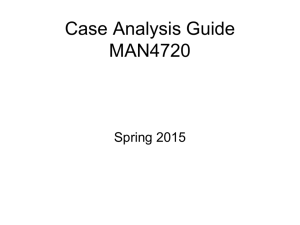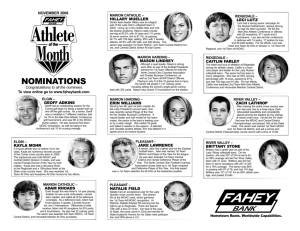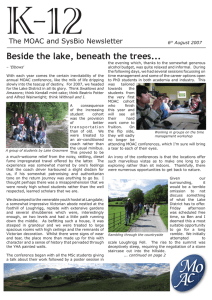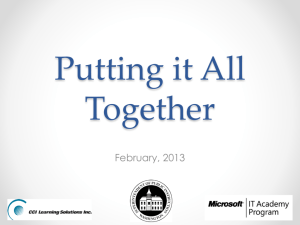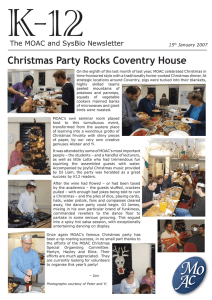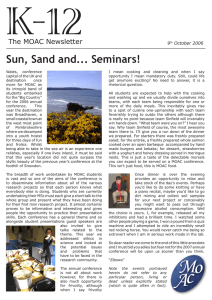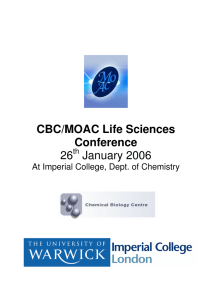K-12 Gathering of interdisciplinary minds at Warwick The MOAC and SysBio Newsletter 1
advertisement
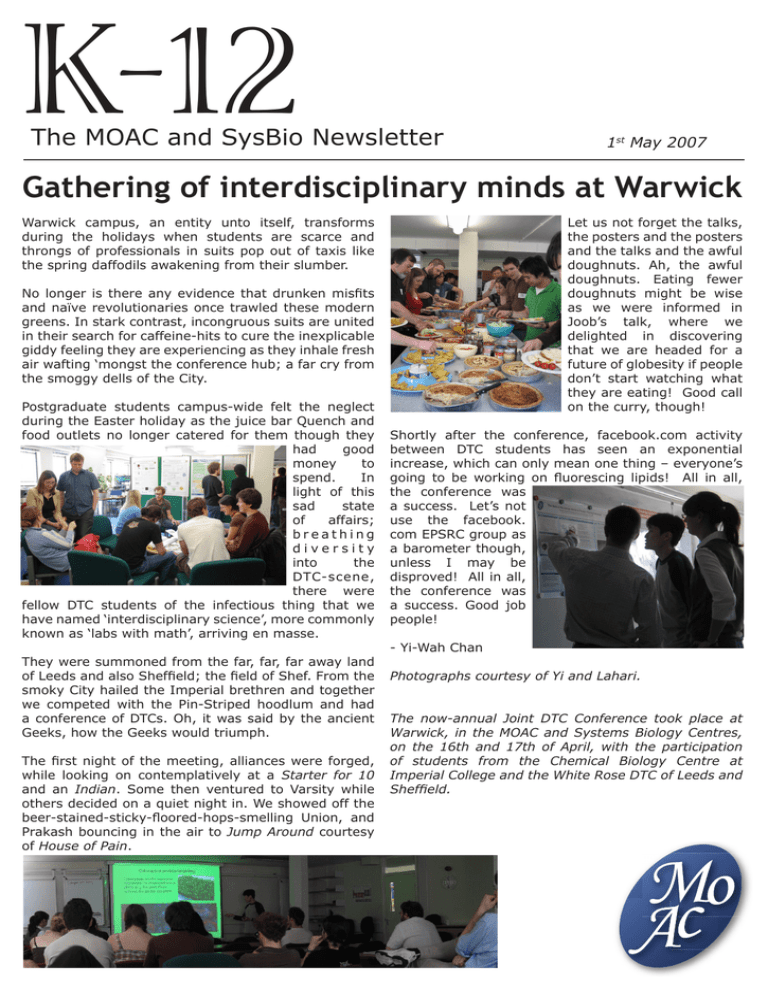
K-12 The MOAC and SysBio Newsletter 1st May 2007 Gathering of interdisciplinary minds at Warwick Warwick campus, an entity unto itself, transforms during the holidays when students are scarce and throngs of professionals in suits pop out of taxis like the spring daffodils awakening from their slumber. Let us not forget the talks, the posters and the posters and the talks and the awful doughnuts. Ah, the awful doughnuts. Eating fewer doughnuts might be wise as we were informed in Joob’s talk, where we delighted in discovering that we are headed for a future of globesity if people don’t start watching what they are eating! Good call on the curry, though! No longer is there any evidence that drunken misfits and naïve revolutionaries once trawled these modern greens. In stark contrast, incongruous suits are united in their search for caffeine-hits to cure the inexplicable giddy feeling they are experiencing as they inhale fresh air wafting ‘mongst the conference hub; a far cry from the smoggy dells of the City. Postgraduate students campus-wide felt the neglect during the Easter holiday as the juice bar Quench and food outlets no longer catered for them though they had good money to spend. In light of this sad state of affairs; breathing diversity into the DTC-scene, there were fellow DTC students of the infectious thing that we have named ‘interdisciplinary science’, more commonly known as ‘labs with math’, arriving en masse. They were summoned from the far, far, far away land of Leeds and also Sheffield; the field of Shef. From the smoky City hailed the Imperial brethren and together we competed with the Pin-Striped hoodlum and had a conference of DTCs. Oh, it was said by the ancient Geeks, how the Geeks would triumph. The first night of the meeting, alliances were forged, while looking on contemplatively at a Starter for 10 and an Indian. Some then ventured to Varsity while others decided on a quiet night in. We showed off the beer-stained-sticky-floored-hops-smelling Union, and Prakash bouncing in the air to Jump Around courtesy of House of Pain. Shortly after the conference, facebook.com activity between DTC students has seen an exponential increase, which can only mean one thing – everyone’s going to be working on fluorescing lipids! All in all, the conference was a success. Let’s not use the facebook. com EPSRC group as a barometer though, unless I may be disproved! All in all, the conference was a success. Good job people! - Yi-Wah Chan Photographs courtesy of Yi and Lahari. The now-annual Joint DTC Conference took place at Warwick, in the MOAC and Systems Biology Centres, on the 16th and 17th of April, with the participation of students from the Chemical Biology Centre at Imperial College and the White Rose DTC of Leeds and Sheffield. 2 Editorial This term has flown by with successes and broadening of horizons in the form of student conferences and EPSRCorganised workshops. Finding out that there are people outside the MOAC common room who can actually relate to what you are talking about when explaining your PhD is indeed a relief. In fact, quite an uplifting realisation. Announcements We welcome into our midst, the latest addition to MOAC, Sara. Baby daughter of Monica, our MOAC MSc coordinator, she is our newest source of fascination and the reason behind the latest craze of baby-gazing sweeping through the MOAC common room. Congratulations, Monica and Fabio! Despite the common room being rather empty these days due to the MSc students working on their miniprojects in various labs, we look forward eagerly to the hustle and bustle of the MOAC annual conference in a few weeks, and not least the delightful setting of the Lake District. Await our next issue for all the happenings from this event and more! - Lahari de Alwis The addition of Sara to our group unfortunately meant that we had to lose Monica for awhile. Nevertheless, we were placed in the capable hands of Phil Richardson in the meantime. Here’s Phil with a few words about himself. I’ve been at MOAC for about 10 weeks covering Monica whilst she’s on maternity leave. Despite Monica’s return to work (as this is being written) my days aren’t numbered yet as I have been asked by Alison to coordinate a MOAC publicity group in the coming weeks. Prior to this I have worked for two charities, a big computer company and picked up a degree in Sociology along the way. And despite my degree I’ve still not been asked “Big Mac and fries, please”, so I count this as a success. I love languages and always like learning new ways to communicate. So let me know if you can teach me some sign language or some Erdu or something similar. Computer technology moves on - Mike Li Computers are becoming especially important in research; notable examples being the handling of biological data and simulations requiring a large number of calculations. It may have gone unnoticed, but the latest Toshiba laptops supplied to MOAC MSc students contain dual-core Intel processors, best thought of as two CPUs (central processing units) squeezed into the same package. Our brief exposure to molecular dynamics (computational Chemistry) and numerical methods in the MSc year hid the details of many practical aspects. Computationally intensive tasks must often be accomplished on computers with many separate processors (for example, the blade-based SGI Altix 3700BX2 supercomputer managed by the Centre for Scientific Computing) or by using a cluster of separate computers (for example, the Interdisciplinary Programme for Cellular Regulation’s 17 duo- BlueGene/L Number one on the Top500 list of processor AMD Opteron cluster). supercomputers, at the time of writing, is the IBM BlueGene/L with 131072 Looking ahead to the future, Intel is presently offering the first consumer processors managing 280.6teraFLOPS quad-core (the confusingly named Intel Core 2 Quad) and AMD expects to (floating point operators per second). ship its “Barcelona” quad-core processor in the final quarter of this year. The Image from www.llnl.gov latest innovations are grid computing and virtualization. Sun Microsystems is providing a grid of over a thousand computers for online access at $1 per hour of CPU time. Amazon is testing its Elastic Compute Cloud online facility where its customers can make use of Amazon’s computer hardware by virtualization, a way of making better use of computer resources by using the same physical computers to run multiple operating systems (an example would be running two instances of Windows Vista on the same computer so the processor spends less time idle). It seems the US is ahead on the technology so we may be confined to niche areas of biological research, at least on the computational front, for a little longer. 3 Bonding, Building & Personal Development - Alistair Irvine The end of March sees the annual trip to Scalford Hall for first year PhD students. This is an EPSRC-funded team development course run by the UK GRAD Programme. The doctoral training centres (DTCs) represented this year were the Chemical Biology Centre from Imperial and the White Rose from Leeds and Sheffield, as well as MOAC. Our first task was to get to know each other with “Network Bingo”, from which Antonia emerged victorious. Much of the rest of the day involved learning about psychological dichotomies and doing our own self-assessed psychometric testing. This is where you learn if you are an introverted thinker, an extroverted feeler or some other such permutation. After a handsomely proportioned dinner, communication skills were exercised by trying to explain someone else’s PhD using a physical prop. This led naturally to some alcohol-assisted bonding via general conversation around the bar. Here endeth the first day. Day two began with p a s s i o n lots of passion. No, the interDTC bonding didn’t go overboard the previous evening. This was a one-man show of passion involving Nelson Mandela and Cadbury’s Celebrations! It was all about toilet warm-ups as a preamble to brilliant presentations. Next, it was time to get some fresh air in the misty grounds of this Leicestershire estate. Our teamworking skills were put through their paces as we engaged in physiological warfare with a few planks of wood and a length of rope. Shark-infested waters were no match for the knot-tying skills of highly-trained scientists. Some post-game horseplay resulted in one smaller, oval-shaped member of Team Yellow exploding over Phil’s head. Gravity duly aided its yolk contents through his now-shiny hair. Giant Jenga and ping pong were among other activities practised in our precious free time. After another Garfield-sized lunch, we put our business heads on. Our challenge was to get lots of money to invest in our own little biotech empire. It was a highpressure, short deadline exercise that required all the skills of good teamwork. The science of vaccines had to be coupled with the finance of equity holdings to negotiate deals with the money men. All was revealed in the Dragon’s Den, where only the best business plans would survive the wrath of the venture capitalist. Here endeth the second day. The third day began with a t o i l e t warm-up. Then we all learned how to be assertive and give g o o d feedback. A f t e r losing our marbles in another outdoor game (involving marbles), we prepared another presentation. For this one we were trying to get lots of money to do some valuable scientific research. Having asserted our passion for all things science, we got some useful feedback. A few moments for reflection involved us pairing up and meandering around the gardens of Melton Mowbray’s finest house. Observers of the rambling duos likened those involved to patients of a stereotyped mental institution. Is this the future of science in the UK? We tried to summarise our experiences of the last few days through our theatrics on stage. Among the highlights were Antonia performing in a comical puppet duet and Elina exposing her drama talents in a silent ode to chairs. An emotional display of photographic evidence brought formal proceedings to a close. Some jovial banter over a few drinks allowed the inter-DTC bonding experience to continue into the night. Here endeth the third day. A quick breakfast and some fond farewells brought the Scalford experience to an end. We all enjoyed the experience and hopefully learned something useful too. It was nice to meet our colleagues from Imperial and Leeds/Sheffield. We look forward to meeting them again soon. 4 Organising a conference in bite-size chunks - Martyn Rittman Getting an idea going… Way back in November I was in touch with Emma Clay from Imperial about a possible collaboration in the lab. This was as a result of a conference on creativity from which my year group returned less than inspired. We decided that perhaps we should have a conference on our own terms, following in the footsteps of a visit to Imperial last year. Our aims were to give some of our colleagues practice at presenting talks and poster and to give lots of time for networking, which we felt has been lacking from earlier encounters. A few phonecalls and chats later and the White Rose DTC was in on the act as well. Bigger and better? Three DTCs combined meant up to 120 people could be turning up, so the MOAC seminar room simply wasn’t going to be big enough. Dorothea and I spent several weeks trying to chase up central time-table organisers to get hold of a lecture theatre, but this didn’t bear much fruit. We decided to innovate and squeeze everyone into Coventry House, which I think proved to be one of the best decisions we made. We could reduce the amount that everyone needed to move around and, by running parallel sessions of talks in smaller rooms, delegates could choose Checking acoustics and arm-waving space in which sessions to attend. the seminar rooms Recruiting Something like this just cannot be done on your own, so I owe a huge thank you to those who helped out. Lahari and Joob were coerced into sorting out the talks (including the abstracts and programme order), Gemma to do logistics, Mike and Richard to run the poster sessions and Yi to arrange the food side of things. Also, Emma at Imperial and Sally in Sheffield who sorted things at their r e s p e c t i v e universities. At the end of the day many others also chipped in to move things, set out food, put up notices and so on, which made my life a whole lot easier and meant the conference ran incredibly An essential part of the workforce, attempting smoothly. to satisfy the hungry masses The calm before the storm One of the keys to a successful event of any kind is preparing in advance, and the week before consisted of attempting to make some progress on the PhD while finalising accommodation, food orders and the programme, sourcing poster boards, finding out when everyone was going to arrive and so on. As with everything else the organising team leapt into action and by Friday evening I was feeling really positive and looking forward to Monday with eagerness rather All set up for the curry than dread. Dealing with logistics and lots of eager students waiting to be entertained, enlightened and enriched, on the day. Results and discussion You can judge for yourself how the rest of it went. I still can’t believe that we had no major disasters and that I managed to enjoy it all so much myself. I put it down to a combination of forward-planning, luck and having willing people to help out. Revelling in the applause and appreciation for a job well done. If you want my advice for planning a conference, I’d say go for it! Try to think of all the eventualities in advance; be flexible and don’t worry too much about the little things that go wrong. At the end of the day, if all the delegates have learned something and had a good time, you have to call it a success! 5 How is a DNA molecule like a worm? - Adair Richards I have to admit, this was not a question that kept me up at night until six months ago and now, I have (only once, so far!) dreamt of just such a conundrum. Such is the all pervading nature of PhD life that I will never look at these elongated soft-bodied invertebrates in the same way again. This story begins one autumnal afternoon whilst answering a string of reviewer’s comments on another article on DNA. One of these asked for a reference for our definition of persistence length, which is a way of quantifying the flexibility of DNA. Imagining this would only be a 20 minute job, I searched for the relevant papers. Little did I know then, of the gaping chasm of decent literature on this subject which led to my finding not one, but several definitions for persistence length – all different – and leaving me at a loss to prove their equivalence. So, in came the cavalry of Martyn, Alison and a number of mathematical bods to assist in my quest to prove the equivalence of these definitions. Unfortunately, this turned out to be a wander up the proverbial blind alley as it is pretty useless trying to prove the equivalence of things which are not equivalent. Thus, we stumbled across the opportunity for some good old fashioned theoretical research and the idea for a paper was birthed. As time has gone on, this paper has blancmanged from a footnote in the first paper, through a small paper in a technical journal, to a full-blown diatribe on DNA, worms, old German physicists, bodged results, clever Russian families and the like. The problem arises from how one models something as complicated as in vivo DNA as a simple enough polymer to extract some kind of meaningful and comparable parameter for its flexibility. Furthermore, to be of any use, this parameter must be able to be determined experimentally in a reliable way. The first major snag in this quest was realising that most of the theoretical physics which underpins this modelling was done in the early twentieth century, before DNA structure was discovered, and published From the cover of Chemical Society Reviews. Taken from the article co-authored by Adair in the 2007, 36 issue. almost exclusively in untranslated German and Russian. I did get excited ordering translations of these articles only to find they had been translated into French, not English! As knowledge has grown about DNA and its in vivo environment, these models have been adapted, built upon and sometimes thrown out altogether in favour of something completely different. The main idea generally accepted today is that DNA behaves somewhat like a worm (as opposed to a steel girder or some string) and whilst this concept is helpful, we thought that perhaps a little more mathematical rigour was required. And so, after several months of burying my head in books and papers, filling reams of scrap paper with barely comprehensible maths and writing endless versions of this ballooning article, eventually it was time to go through it word-for-word with Martyn and Alison. I first realised this was not going to be a short task when after an hour of discussing the first two paragraphs, we argued for ten minutes over the appropriateness of a particular comma. Never have I had more distaste for the rules of English grammar. I imagine that many a good supervisor-student relationship has been put under strain by a careless semi-colon here, or a misused apostrophe there. I wish I could end this article by telling you that the ensuing article is now in print so please read it and there will be a quiz at the end of the week etc. However, the truth is that I am still buried in the depths of version sixteen, debating the rights and wrongs of a particularly tricky equation and wondering whether this article will ever see the light of day. But then, I remember that this is exactly how I felt a couple of weeks before submitting my last article which is now out in glorious Technicolor. So maybe there is hope yet and one day, I may even finish my PhD! 6 Calendar – Useful Dates for the near future 2007 8th - Warwick Postgraduate Poster Competition 22nd–24th - Bio Sciences Postgraduate Symposium 24th–27th - MOAC Annual Conference June 25th–26th - Edinburgh DTC Conference: 3rd and 2nd year PhD students only 27th - Chemistry Postgraduate Symposium (to be confirmed) 30th - End of Autumn term 3rd–5th - Science Communication Workshop: 2nd year PhD students only May July Upcoming Wednesday Seminars The MOAC seminars will recommence on the 2nd of May. Date: Place: Time: Every Wednesday, during university term time MOAC Seminar Room, 2nd floor of Coventry House 12:50pm — Free ploughman’s-style lunch 1:10pm - 1:45pm — Seminar Minibus transport to and from the Gibbet Hill site is usually provided. There is always transportation from and to HRI. 2nd May Supracolloidal structures through liquidliquid interface driven assembly Stefan Bon, Chemistry MOAC Cake Day “Can you cook?” Perhaps a strange question to be asked at an interview for an interdisciplinary doctoral training programme, but that is just what you will be asked when applying for a place at MOAC. Considered a direct indication of your ability to conduct experimental science successfully, what better way to put it to the test than to organise a cake day? The MOAC Cake day, which was inaugurated in January, has been a success, showcasing the baking talents of many of our members and bringing everyone together on a monthly basis. We have had an array of “cakes”, ranging from luxurious gateau operas through tantalising tiramisus, scrumptious chocolate cakes and irresistible marble cakes to bite-sized pieces of heaven in the shape of mince pies, whisky fudge, banana muffins and chocolate brownies. We have even been treated to some jewels of original recipes in the form of a passion fruit meringue sponge and an upside-down creamfilled castle of sponge fingers. Special applause goes to those who produced delicious offerings, in the form of lemon and sponge cakes, on their very first attempt. This event will continue on, despite the increasing girths of the faithful, in the hopes of unearthing more hidden talent and honing those baking skills. See you all on the next third Friday of the month! 7 7 Deadly Things and 2 Prizes - Richard Wilson “It’s too bad she won’t live… but then again, who does?” comments Gaff as the lovers escape at the end of Ridley Scott’s 1982 film Blade Runner. He’s referring to Rachael who is a replicant: engineered to appear just like a human but made of synthetic components that are somehow free from ageing. The catch is she’s been designed to deactivate after a few years. Back in the real world, Aubrey de Grey has taken an engineering approach to understanding ageing (http://www.sens.org). We all want a healthy old age but, despite advances in medical science, getting older remains the biggest single risk factor for debilitating diseases such as arthritis, heart disease, cancer and dementia. There are two medical approaches to tackling the problem: geriatrics aims to treat the symptoms and gerontology investigates the causes of ageing. Gerontology has a long way to go and geriatrics doesn’t solve the problem so Aubrey David Nicholas Jasper de Grey proposes a middle way as the fastest way to combat ageing: fix the damage before it becomes untreatable. This idea is based on the widely accepted view that ageing is the accumulation of damage which the body’s maintenance systems cannot repair. Dr. Aubrey de Grey Photograph by Mr. Kevin Perrot. Dr. de Grey calls his programme SENS Strategies for Engineered Negligible Senescence. Senescence is the term for the deleterious effects of ageing. The table summarises what he sees as the 7 obstacles to a healthy old age and the fixes that need research and development. Obstacle Fix Cell loss and atrophy Growth factors and stem cells Accumulation of unwanted cells Immunotherapy Mutations in chromosomes Stem cell replacement Mitochondrial mutations Insert mitochondrial genes into cell nucleus Junk inside cell Digestion by engineered lysosomes Junk outside cell Immunotherapy Protein cross-linking Enzyme therapy De Grey believes that concentrating research on these therapies is the best way to bring us a healthy old age. As an encouragement, the Methuselah Foundation is offering the Methuselah Mouse Prize (worth over $4 million) to researchers who extend the healthy lifespan of mice to 5 years (http://www.mprize.org). Detractors claim that he doesn’t properly understand the biology and, because he has no laboratory experience, he grossly underestimates the technical difficulties of making progress. A $20,000 prize awaits any molecular biologist with a record of publication in biogerontology who can prove that SENS is “so wrong that it is unworthy of learned debate” (http://www. technologyreview.com/sens). What do you think: is SENS a naïve programme, either duplicating existing research or doomed to waste valuable effort, or could it be the most effective way forward? Who says Scientists aren’t funny? A grad student, a post-doc, and a professor are walking through a city park and they find an antique oil lamp. They rub it and a genie comes out in a puff of smoke. The genie says, “I usually only grant three wishes, so I’ll give each of you just one.” “Me first! Me first!” says the grad student. “I want to be in the Bahamas, driving a speedboat with a gorgeous woman who sunbathes topless.” Poof! He’s gone. “Me next! Me next!” says the post-doc. “I want to be in Hawaii, relaxing on the beach with a professional hula dancer on one side and a Mai Tai on the other.” Poof! He’s gone. “You’re next,” the genie says to the professor. The professor says, “I want those guys back in the lab after lunch.” 8 Accomplishments Other achievements: Published articles: Yi is first author of “Pigment composition and adaptation in free-living and symbiotic strains of Acaryochloris marina”, which is currently in press for FEMS Microbiology Ecology. Peter is a co-author of the chapter “Myxobacterial Two-Component Systems” from the book “The Myxobacteria” (2007, D.E. Whitworth, ed. ASM Press, Washington DC.), which is currently in press. As reported in the previous edition of the newsletter, the papers in press can now be found in the following publications. “Synthetic metallomolecules as agents for the control of DNA structure” – Adair D. Richards and Alison Rodger. Chemical Society Reviews, 2007, 36. An image from the article was used on the cover page of this issue. Daniel was awarded a prize for his poster, presented at the Joint DTC conference at Warwick. Adair’s research was featured on the front page of the March 2007 issue of the Chemical Society Reviews journal. He is one of the youngest authors to receive this honour. As a result of this achievement, he has been featured on Radio 5Live, the Coventry Telegraph and a dedicated Warwick podcast. As usual, MOAC students have excelled outside the academic arena. ★ Ratchada participated at the annual Samaggi Games, which is the annual sports event held by the Thai community of the UK, and came away with a gold medal in the women’s badminton doubles event and a silver in the women’s squash singles event. ★ A photograph taken by James Sinfield was used on the cover of the book of poetry, “The Yarrow Tree”, published by the Heaventree Press in Coventry. ★ Martyn has his very own radio show on RaW radio. Check out “Rittman’s Revenge” at 10pm every Wednesday of term on 1251AM or online at www. radio.warwick.ac.uk! ★ More University Challenge success, this time in the ultimate form of Prakash and the rest of the Warwick team lifting the trophy with a comfortable win over Manchester in the final. Prakash has since enjoyed celebrity status, having appeared on local papers, the BBC news website and even on the national news. Photograph used on the cover of “The Yarrow Tree” ★ It seems that MOAC is destined to supply members of the Warwick University Challenge team, with Howard being selected for this year’s team. We wish them well in their attempts to keep the trophy on at Warwick for another year.
